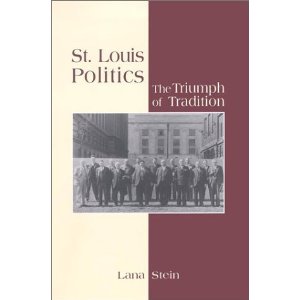Last week I wrote about congressional redistricting, and the messy inter- and intra-party hostility it engenders – and is currently sparking in my home state of Missouri.
And as hypothesized, more hostility developed in Missouri following the Legislature’s override of Governor Nixon’s veto of the map. Because Missouri lost a seat during the apportionment process, the new map divides up Congressman Russ Carnahan’s district among four other districts, and Rep. Carnahan has been lashing out – first a few weeks ago at his fellow Missouri Democrat Rep. Lacy Clay, and then a few days ago at another Missouri Dem, Rep. Emanuel Cleaver, for going along with the decimation of his district. Of course, he is more privately seething at the four Democratic members of the state House who defected and voted for the override.
Does anyone really think Rep. Carnahan would be working to kill the map if the Republican Legislature had proposed to divide Rep. Clay’s district four ways and force him to run in an overwhelmingly white district? If you do, you’ve probably never seen Jane Elliot’s famed Brown Eyes, Blue Eyes experiment – and you don’t know much about human nature. Instincts for self-preservation are strong, power intoxicating, and race often wielded as a tool to gain and maintain it.
***
Now, surely Rep. Carnahan is angry at the Republicans for drawing these maps, but that anger is mild: he had to have expected it from them. Carnahan’s more visceral fury has been directed at his co-partisans.
Besides being Democrats, what do the people Rep. Carnahan is angriest with have in common?
They’re all black.
Timothy Carney of the Washington Examiner notes as much – and he notes that the major Missouri newspapers have downplayed the racial angle of the tussle. More broadly, Carney contends that the mainstream media (MSM) tends to gloss over racial strife within the Democratic party.
I don’t agree with the Examiner on much other than education reform, but Carney may have a point here. Given the choice, the MSM often would rather cover splits between the Tea Party and the Republican establishment than splits between blacks and the Democratic establishment.
***
It’s been interesting to see the blame being placed on black elected officials when the person who may merit the most blame for Rep. Carnahan’s predicament is none other than…his sister.
Sister Robin, Missouri’s Secretary of State, led the Democratic ticket in 2010 as our U.S. Senate nominee. In the prototypical swing state of Missouri, Robin received 42%, losing by nearly 15 points. State House Democrats lost 17 seats in the washout, which put Republicans within striking distance of the 2/3 majority needed to override the governor’s veto.
Given the fact that this abysmal 2010 performance is the primary reason Republicans were in a position to muster a 2/3 majority for the map that draw Rep. Carnahan out of existence, one might think Rep. Carhanan would be somewhat loathe to blame others. But, to his credit, Rep. Carnahan or his handlers may have realized that the press is well-conditioned to the meme of blacks acting to advance black political power over the interests of the Democratic Party. Indeed, these racial splits within the Democratic Party are nothing new; they’ve happened in many (mainly Southern) states for decades.
Just as LBJ predicted upon signing the Voting Rights Act, Southern and border state Republicans would tar Democrats as “the black party” because of blacks’ loyalty – and the consequent allegiance of most whites to the other party. Part of the Republicans’ “Southern strategy” conceived by Nixon strategist Kevin Phillips in 1972 and later refined by Lee Atwater of (Willie Horton fame) is to defeat moderate white Democrats. If the only visible representatives of the Democratic Party are liberal blacks, ergo, Democrats are “the black party.” Or, in a more politically correct era, “the urban party.”
***
Splits in the Democratic coalition usually rear their ugly head right after each decennial census. That’s because in states with significant black populations (especially Southern states where black voters are less likely to be clustered in major cities and thus require gerrymandering to comprise a majority within congressional districts), black Democrats often ally with Republicans to support the creation of majority-black districts. Black Democrats do it because they want safe districts not just in the general but in the primary; Republicans do it because they want to group as many of the most reliable Democratic voters (blacks) into a few districts while bleaching the surrounding districts and thus helping Republicans win.
In most states most of the time, the creation of majority-black districts maximizes the efficiency of the Republican vote while minimizing that of the Democratic vote: that is, tons of Democratic votes are wasted in general elections since Democrats are “packed” into 70+% Democratic districts, while Republicans are efficiently distributed across a larger number of districts that are approximately 55% Republican.
In addition to ensuring that Missouri’s redistricting process comports with the Voting Rights Act, the propping up of Rep. Clay – and concomitant dissolution of Rep. Carnahan’s district – not only renders surrounding districts unwinnable for Democrats, but has the added benefit of reinforcing Republicans’ attempt to brand MO Democrats as “the urban party.”
***
And just as the strategy behind redistricting was premised upon race, and the recriminations were based largely upon race, any primary between the like-minded MO Reps. Carnahan and Clay would also be about race.
The voting-age population of Rep. Clay’s new district is 45.5% black and 48.3% white. Though district blacks are more likely to be Democratic than whites (advantaging Rep. Clay), this advantage is offset by historically higher primary turnout among whites than blacks (advantaging Rep. Carnahan).
And, in a city that has been approximately half-black and half-white for a generation – and a city where race has often been correlated with voting for a candidate of the same race at 90+% frequency, there is a rich tradition in elections with racially split electorates: the stalking horse. As Dr. Lana Stein noted in her classic, “St. Louis Politics: The Triumph of Tradition,” the city has a long tradition of candidates filing for races with the sole purpose of drawing votes away from the frontrunner. Sometimes, this is accomplished by running someone with the same name as one’s opponent; other times, it is simply done by recruiting a candidate of the same race.
Occasionally, a candidate can even recruit a stalking horse who meets both criteria, as in 1983, when young black upstart Freeman Bosley Jr. faced incumbent Joe Roddy Sr. for the office of Circuit Court Clerk. A candidate named C. Jo Roddy, mysteriously filed on the last day, and received over 2,000 votes despite spending almost no money and making no campaign appearances. Bosley won by less than 1,000 votes and went on to become the city’s first black mayor. Not surprisingly, Clara Jo Roddy was never heard from again in political circles.
***
I have no idea if Rep. Carnahan will decide to contest the racially split 1st CD or not in 2011. If he does, he’d have a decent shot at winning.
But the sad fact is, the ultimate result may have nothing to do with the campaign that either candidate wages, or the quality of either candidate. It may hinge solely upon the race, last names, and combination of people who file for the seat. So, instead of cursing Lacy Clay, Russ Carnahan may be better off spending his time trying to convince a local black school board president named Stacy Clay that he is congressional timber.
And of course, someone in the Clay camp is probably thinking the same thing right about now. If only Carnahan were a more common name….
But hey, a Rex Callahan would suffice, right?












Leave a Reply